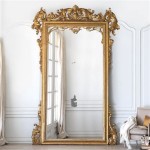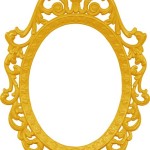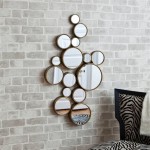How To Use Mirrors To Brighten A Dark Room With Light
Dark rooms present a common interior design challenge. Limited natural light can lead to a gloomy atmosphere, making a space feel smaller and less inviting. While artificial lighting is essential, it often fails to replicate the warmth and vibrancy of sunlight. Mirrors, however, offer a powerful and elegant solution for amplifying available light and creating a brighter, more open environment. By strategically placing mirrors within a dark room, it is possible to reflect and redirect existing light sources, both natural and artificial, to dramatically enhance illumination and improve the overall aesthetic.
The principle behind using mirrors for brightening a room is based on simple physics: light reflects off smooth, reflective surfaces. When a mirror is positioned to capture and bounce light, it effectively doubles the perceived intensity of that light source. This reflected light then spreads throughout the room, reaching areas that would otherwise remain shadowed. Mirrors can also create the illusion of greater depth and space, further contributing to a sense of brightness and openness. The success of this technique hinges on careful planning and consideration of the room's layout, existing light sources, and the type and placement of the mirrors themselves.
Strategic Mirror Placement for Maximum Impact
The most crucial aspect of using mirrors to brighten a dark room is their placement. A poorly positioned mirror can be ineffective or even counterproductive, reflecting uninteresting areas or creating unwanted glare. The key is to identify the primary light sources in the room, whether it's a window, a doorway, or an artificial light fixture, and then position the mirror to capture and amplify that light. Several strategies can be employed to achieve optimal results.
One common approach is to position a large mirror directly opposite a window. This placement effectively doubles the apparent size of the window and maximizes the amount of natural light entering the room. The mirror acts as a secondary light source, bouncing the sunlight deeper into the space and brightening areas that would otherwise remain dim. The size of the mirror should be proportional to the size of the window. A larger mirror will reflect more light, but it can also appear overwhelming in a small room. Experimentation may be necessary to determine the ideal size and placement.
Another effective strategy is to position mirrors along walls adjacent to windows. This technique is particularly useful in rooms where a window is not directly facing the area that needs brightening. By placing a mirror on a side wall, it can still capture and reflect the natural light, redirecting it towards the darker areas of the room. This approach can also create a more dynamic and visually interesting effect, as the reflected light will shift and change throughout the day as the sun moves.
Furthermore, consider placing smaller mirrors in strategic locations to target specific dark spots. These mirrors can be used to reflect light from a nearby lamp or even a brighter area of the room, directing it towards a shadowed corner or alcove. A collection of smaller mirrors can also create a mosaic effect, adding visual interest while simultaneously brightening the space. The key is to carefully assess the room's lighting conditions and identify the areas that would benefit most from additional illumination.
Selecting the Right Type of Mirror
The type of mirror used can also significantly impact its effectiveness in brightening a dark room. Different types of mirrors offer varying levels of reflectivity and can contribute to the overall aesthetic of the space. Consider the size, shape, and framing of the mirror, as well as its placement, to ensure that it complements the room's design and maximizes its light-enhancing capabilities.
Large, unframed mirrors are often the most effective for reflecting light, as they provide a seamless and unobstructed surface. These mirrors can be particularly useful in small rooms, as they create the illusion of greater space and depth. However, unframed mirrors may not be suitable for all design styles. Framed mirrors can add a touch of elegance and sophistication to a room. The frame can be chosen to complement the room's decor and add visual interest. However, it is important to ensure that the frame does not obstruct too much of the mirror's surface, as this can reduce its reflectivity.
Antique mirrors, with their slightly distressed or aged surfaces, can also be used to add character and warmth to a room. While they may not reflect as much light as a pristine mirror, their unique aesthetic can contribute to a more inviting and comfortable atmosphere. The subtle imperfections in the glass can also diffuse the light, creating a softer and more flattering glow.
Mirrored furniture, such as mirrored side tables or chests of drawers, can also be used to brighten a dark room. These pieces of furniture not only reflect light but also provide functional storage space. The mirrored surfaces can add a touch of glamour and sophistication to the room, while the furniture itself can help to organize and declutter the space.
Optimizing Light Sources for Mirror Reflection
While mirrors are effective at reflecting and amplifying existing light, their impact is maximized when combined with strategically placed and optimized light sources. The quality and intensity of the light being reflected play a crucial role in determining the overall brightness of the room. Therefore, it is important to consider the type of lighting fixture, the color temperature of the light bulb, and the placement of the lights relative to the mirrors.
When using artificial lighting, opt for fixtures that provide ample, diffused light. Avoid harsh, direct lighting, as this can create unwanted glare and shadows. Lamps with fabric shades or frosted glass diffusers are ideal for creating a soft and even glow. Position these lamps strategically to illuminate the areas that you want the mirrors to reflect. For instance, placing a lamp near a wall-mounted mirror can create a dramatic and visually appealing effect.
The color temperature of the light bulb also plays a significant role in the overall brightness and atmosphere of the room. Warm white light (around 2700-3000 Kelvin) creates a cozy and inviting atmosphere, while cool white light (around 4000-5000 Kelvin) provides a brighter and more energizing illumination. Experiment with different color temperatures to determine which best suits the room's purpose and your personal preferences. Consider using daylight bulbs, which mimic natural sunlight, to maximize the brightening effect of the mirrors.
Furthermore, consider the placement of the light fixtures in relation to the mirrors. Avoid placing light fixtures directly in front of mirrors, as this can create an overwhelming amount of glare. Instead, position the lights to the side of the mirrors, or angle them slightly upwards to direct the light towards the ceiling. This will allow the mirrors to reflect the light more evenly and create a softer, more diffused glow. Dimmers can also be useful for controlling the intensity of the light, allowing you to adjust the brightness based on the time of day and your desired mood.
In conclusion, strategically incorporating mirrors into a dark room can transform the space by maximizing the utilization of available light. Through careful consideration of mirror placement, selection of appropriate mirror types, and optimization of light sources, it is possible to significantly enhance the brightness and create a more inviting and visually appealing environment. The use of mirrors offers a relatively simple and cost-effective solution for addressing the challenges posed by limited natural light, enhancing the overall aesthetic and functionality of the room.

Using The Magic Of Mirrors To Brighten Up Your Home

Using A Core Of Light Mirrors To Amplify Dark Apartment

13 Ways To Brighten A Dark Room

How To Add Light Dark Rooms Day 11

How To Brighten A Dark Living Room Alusplash

How To Lighten A Dark Room Solutions And Remedies

How To Use Mirrors And Glass Enhance Light Space Pabs

How To Use Mirrors Brighten A Room Murray Glass

6 Ways To Use Mirrors Make Your Home Feel Bigger And Brighter

How To Lighten A Dark Room With No Natural Light Renovated







